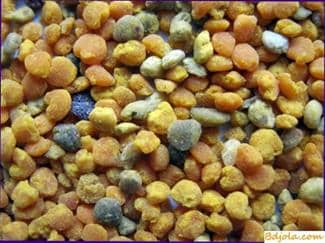Pollen and Perga

Flower pollen has recently enjoyed such a huge success that its value can be placed close to honey.
On a clear summer day, standing not far from the hive hive, one can observe how bees return to their wax city with a load of flower pollen. Collected pollen bees are carried in the “baskets” of the third pair of hind legs. Beekeepers often call these baskets to carry pollen on the legs of bees with “panties”. Indeed, baskets justify this name when they are filled with pollen.
They resemble breeches-breeches. Their color depends on the colors on which the bees have visited: on the colors of the bell and phacelia they are purple; apple, raspberry – white or gray; sainfoin, clover of white and red, meadow cornflower – brown; wild mallow – blue; pear, peach, horse chestnut – red; rose hips, walnut, gooseberries, buckwheat – golden yellow, etc. The guard standing at the tap guard is vigilantly examining the bees flying towards the beehive.
Dressed in green, blue, red, orange, yellow breeches, she misses unhindered, and bees from another hive, appearing without load of pollen and nectar, ruthlessly drive away. Pellets of pollen in the baskets are the best pass for entering the bee town. It is not uncommon for a bee to boldly pass with this most valuable cargo in a foreign hive, and the vigilant protection of a thousands of bee colonies does not obstruct it.

Pollen of different plants differs not only in color and shade, but also in size, the shape of the surface of pollen grains. Thus, the value of pollen grains of various species of uv and birch is 7 microns, whereas in plants belonging to the family of pumpkin, their size reaches 150 microns.
Pollen grains (they can be considered only under a microscope) are a genuine treasure trove of wonderful food and
It was found that for the human body, a protein containing all the ten essential amino acids (arginine, valine, histidine, isoleucine, leucine, lysine, methionine, threonine, tryptophan, phenylalanine) is necessary for the human body to be supplied in ready form with food, since it can not be synthesized organism. Flower pollen contains in large quantities all the replaceable and irreplaceable amino acids – those “bricks” from which live cells are created.
Pollen can also be called a natural concentrate of almost all known vitamins. Each pollen grain contains the following vitamins: C (ascorbic acid), B1 (aneurine), B2 (riboflavin), B6 (pyridoxine), Bc (PP-nicotinic acid), B3 (pantothenic acid), H (biotin), Bs (folicum acid), provitamin A (carotene), D (calciferol), E (tocopherol), P (rutin), etc.
Pollen contains very important enzymes that act as biological catalysts. Pollen grains of some plants contain hormonal substances: estrone – female sexual follicular hormones. The French explorer Luvo writes that bullfrogs, before mating, peck up a huge number of apple blossoms. Their craws are literally packed with anthers of these flowers.
Pollen and Perga
